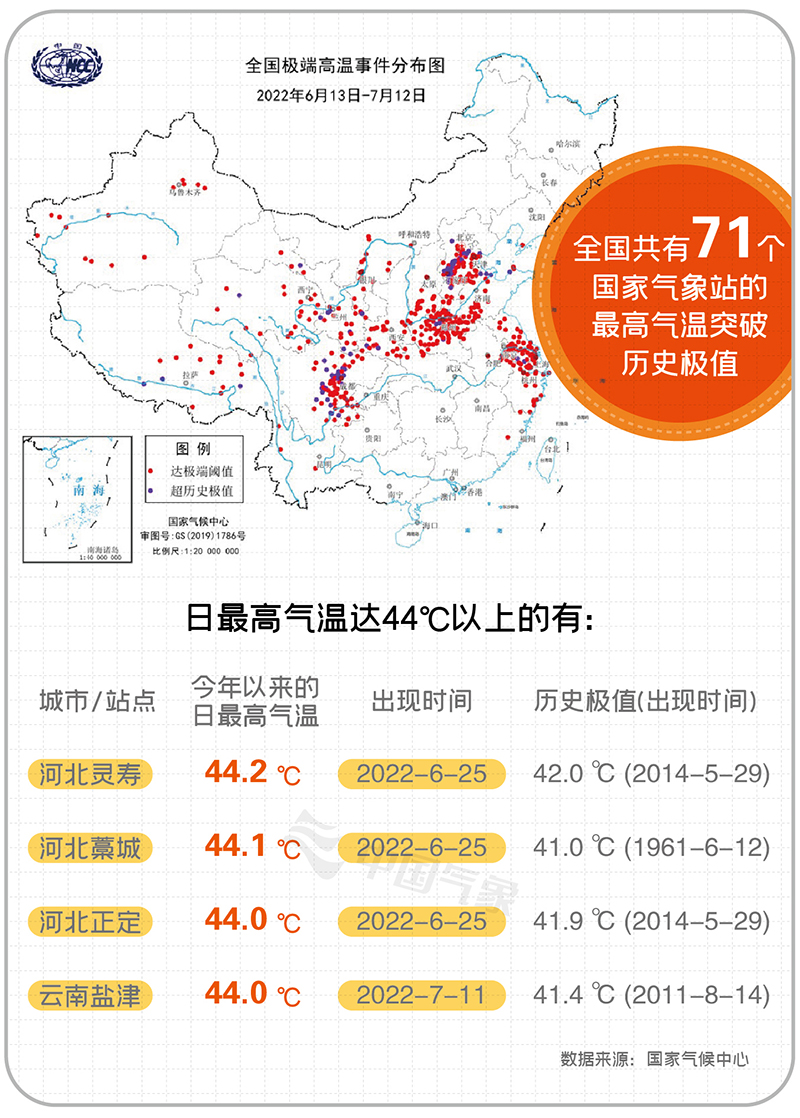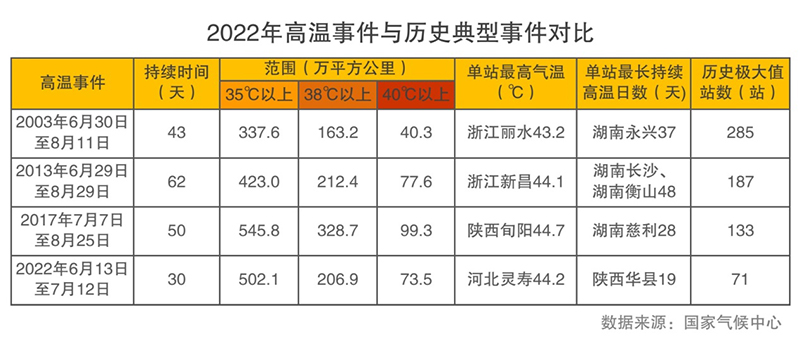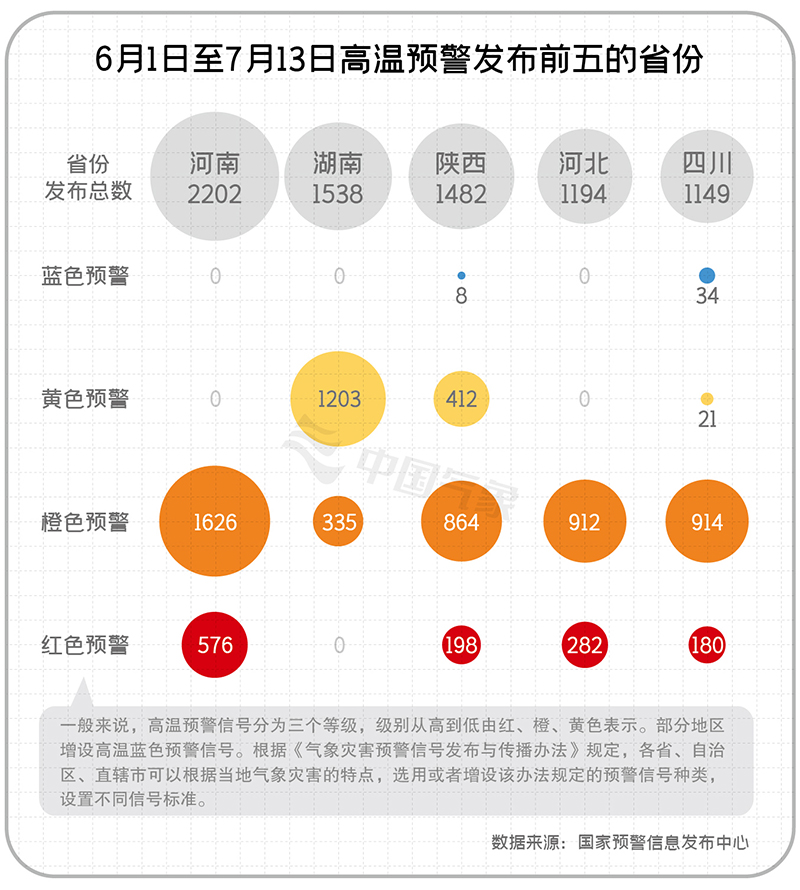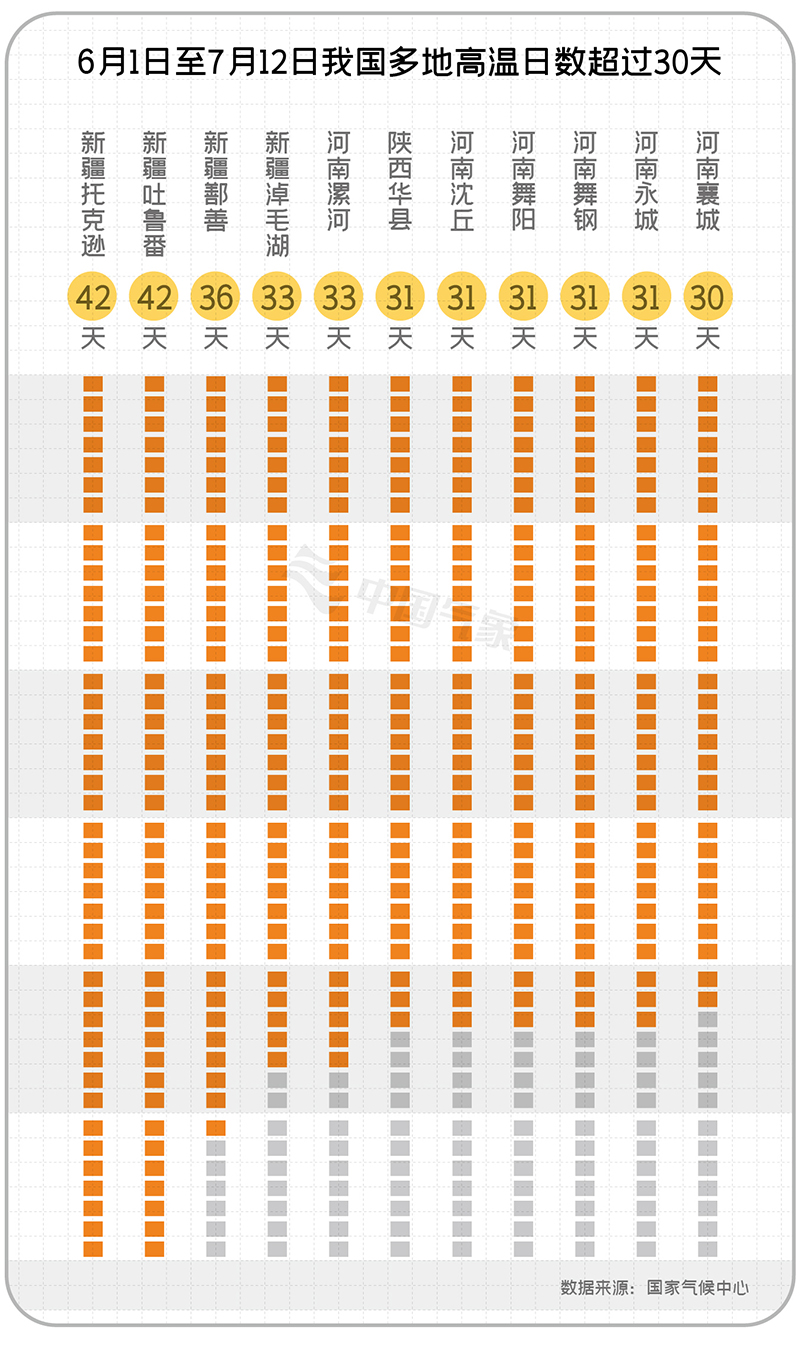The dog days are coming! Meteorological data tell you how hot the weather has been recently.
Expert consultant:
Yuan Yuan, Chief Duty Officer of National Climate Center in Flood Season.
Chen Yu, Chief of Climate Service Office of National Climate Center
Li Ying, Senior Engineer of Meteorological Disaster Risk Management Office of National Climate Center
After entering the light summer solar term on July 7, it ushered in the first stage on July 16, and we are about to face the test of "steaming up and cooking down" in the dog days. Since mid-June, many places in China have started the high-temperature "roasting mode" ahead of schedule, and many cities have experienced high-temperature weather above 40 C. Meteorological data tell you how fierce this wave of high temperature is.
How hot is it this summer?
-There are 71 national weather stations that have broken through historical extremes.
Since June 13th, China has experienced the first regional high-temperature weather process this year, and many places have continued to experience high temperature and summer heat. The Central Meteorological Observatory has issued high-temperature warnings for several consecutive days.
As of July 12, the high temperature event has lasted for 30 days, covering China’s land area of 5.021 million square kilometers and affecting more than 900 million people. The average number of high temperature days in China reached 5.3 days, 2.4 days more than normal, the highest in the same period since 1961. Among them, the number of high temperature days in most parts of East China, Central China, Northeast Southwest China, southwestern Shaanxi, southwestern Shanxi and southern Xinjiang is 5 to 10 days more than normal. The number of high temperature days in northwestern Jiangsu, northern Anhui, most of Henan, northwestern Hubei, southeastern Shaanxi and northeastern Chongqing is more than 10 days than normal.
Since June, the daily maximum temperature of 238 national meteorological stations in Hebei, Henan, Tianjin, Yunnan, Sichuan, Zhejiang, Xinjiang and other places has exceeded the monthly extreme value, and the daily maximum temperature of 71 national meteorological stations has exceeded the historical extreme value. Among the top ten stations with high temperature values, the daily maximum temperature in Lingshou, Hebei (44.2℃, June 25th), Gaocheng (44.1℃, June 25th), Zhengding (44.0℃, June 25th) and Yanjin, Yunnan (44.0℃, July 11th) exceeded 44℃. The daily maximum temperature in Lanzhou, Gansu (37.6℃, June 24th), Yinchuan, Ningxia (37.2℃, June 16th), Tianjin (40.1℃, June 25th) and other provincial capitals or municipalities directly under the central government exceeded the monthly maximum. Shanghai Xujiahui Station not only had the earliest high temperature of 40℃ on July 10th, but also reached 40.9℃ at 14: 30 on July 13th, tying the highest temperature record since the local meteorological record (1873).

June 25th is the day with the largest number of high temperature extreme stations since June, in which the daily maximum temperature of 28 stations exceeded the historical extreme value, and the top ten stations with daily maximum temperature all appeared in Hebei.
According to the monitoring index of regional high temperature process, considering the influence scope, intensity and duration of high temperature events, the comprehensive intensity of this event is the sixth strongest since 1961, second only to 2013, 2017, 2003, 1966 and 2019. Since 2000, the typical years of large-scale sustained high temperature events in China are 2003, 2013 and 2017. Generally speaking, this year’s high temperature event started earlier than the above three years, and the duration and the number of historical extreme high temperature stations are not as good as these three years. Although the influence scope and the maximum temperature of a single station are not as good as 2017, they have exceeded 2003 and 2013.

Comparison between high temperature events in 2022 and typical historical events Source: National Climate Center.
Early warning data can also show the "off the charts" degree of high temperature. Since June (as of July 13th), except Heilongjiang and Liaoning, 29 provinces (autonomous regions and municipalities directly under the Central Government) have issued 15,008 high-temperature warnings, including 1,869 red warnings, 8,931 orange warnings, 4,122 yellow warnings and 86 blue warnings. Among them, the number of high temperature warnings issued on July 10 was the highest, with 857. Henan, Hunan, Shaanxi, Hebei and Sichuan are the provinces that issue the most high-temperature warnings. The top ten provinces that have issued high temperature warnings for the longest time in a row are Henan (31 days), Xinjiang (20 days), Anhui (19 days), Shaanxi (17 days), Sichuan (17 days), Shanxi (13 days), Gansu (13 days), Hebei (12 days), Jiangsu (12 days) and Yunnan (12 days)

From June 1st to July 13th, the top five provinces of high temperature warning release data source: National Early Warning Information Release Center.
The northern hemisphere suffered a "heat wave"
-Extreme high temperatures are hitting many parts of the world.
Extreme high temperature weather is continuing around the world, and high temperature heat wave events spread in Europe, East Asia and North America, and the highest temperature at the same time exceeded the historical extreme.
In mid-June, Europe generally suffered from high temperature and heat waves. On June 10th, hot weather began to appear in Portugal. On the 13th, the temperature in central and southern Spain has exceeded 40℃; On the 18th, the highest peak of this round of high temperature weather occurred in France. As many as 70 provinces issued high temperature warnings, and high temperature records in many places were broken. On the 19th, a record high temperature occurred in Germany, and a forest fire broke out in Brandenburg, forcing about 620 residents to evacuate.
In mid-June, record high temperatures spread from the Great Plains of the United States to the Mississippi Valley and the southeast. More than 125 million people in most States in the central and eastern United States are under high temperature warning, which is more than one third of the population of the United States.
On the afternoon of June 25th, the temperature in Isezaki, Gunma Prefecture, Japan reached 40.2℃, the highest temperature in June since Japan had meteorological records.

Global average temperature anomaly in June 2022 Image source: Global Severe Weather Monitoring Monthly Report.
Why is the high temperature so fierce and strong?
-Global warming and abnormal atmospheric circulation are the main causes.
The sixth assessment report of the United Nations Intergovernmental Panel on Climate Change (IPCC) points out that global warming is happening at an unprecedented speed since 2000 in the last 50 years, and the instability of the climate system is increasing. UN Secretary-General antonio guterres called it a "red alert for all mankind". Global warming is the climate background of frequent high-temperature heat waves in the northern hemisphere, and abnormal atmospheric circulation is the direct cause of frequent high-temperature heat waves in many places around the world since June this year.
Since June this year, over the northern hemisphere subtropical zone, the western Pacific subtropical high zone, the Atlantic high zone and the Iranian high zone have all been enhanced in stages, thus forming a large-scale global warm high zone. Under the control of warm and high-pressure belts, the prevalence of downward flow is conducive to the ground warming. In addition, under the action of a wide range of high-pressure belts, the air is relatively dry and it is not easy to form clouds, which also makes solar radiation reach the ground more easily, leading to frequent high temperatures and strong intensity, which in turn leads to persistent high-temperature heat waves in many places in the northern hemisphere.
Specific to China, the ongoing La Ni? a event has provided an important climatic background for the occurrence and development of high temperature in the south since June this year, especially in July, when the development of the mid-latitude warm and high pressure belt strengthened, resulting in a large-scale high temperature weather. According to statistical analysis, in the summer following most La Nina events, the western Pacific subtropical high (referred to as subtropical high) tends to be northward. Since late June this year, the subtropical high has moved northward, especially after Typhoon Siam moved northward in early July. The subtropical high has been extended westward, and the Iranian high has been extended eastward. Combined with the mid-latitude continental high, a stable warm and high pressure zone has been formed over China, which has caused a wide range of high temperature weather. In addition, due to the water vapor carried by the subtropical high, the humidity in the central and eastern regions of China is relatively high, which makes the human body temperature higher.
Compared with previous years, since July this year, the Iranian high has been extended eastward to form a huge warm high pressure belt with the western Pacific subtropical high and the mid-latitude continental high, which is rare in history. Historically, high-temperature heat waves occurred in Jiangnan, South China, Sichuan and Chongqing due to the extension of subtropical high to the west, or high temperatures continued in northwest China and Xinjiang due to the stable maintenance of continental high. Therefore, this year, the high temperature range is relatively large, the duration is long, and the extremes are also prominent.

From June 1 to July 12, the number of high temperature days in many places in China exceeded 30 days. Source: National Climate Center.
The high temperature will continue
—— Do not treat health protection in production and life lightly.
According to the forecast of the Central Meteorological Observatory, as of July 26, there will be many hot weather in southern China and other places. From July 13th to 16th, it was hot and rainy in Sichuan Basin, Shaanxi Guanzhong, Jianghan, Jianghuai, Jiangnan and South China. From 17th to 20th, there will be rain in Sichuan Basin, Jianghan, Jianghuai, the western and northern parts of the south of the Yangtze River, and the northwestern part of South China, and the high temperature weather will be alleviated, while the southeastern part of the south of the Yangtze River and the eastern part of South China will continue to be hot and muggy. After the 21st, the high temperature in the south will develop again, and the scope will be expanded.
The National Climate Center predicts that from July 27 to August 11, the temperature in most parts of China will be higher than normal, and the temperature in western Inner Mongolia, Shanghai, Jiangsu and northern Zhejiang will be 1℃~2℃ higher, which may lead to a long-lasting high temperature weather process.
High temperature weather will have a great impact on power supply, people’s production, life and health. The public should try to avoid outdoor activities at high temperature, and shorten working hours when working at high temperature. We should pay special attention to heatstroke, prevent, identify and treat it early, especially for the old, weak, sick and young people. Attention should also be paid to the safety of electricity consumption in hot weather, and the power sector should respond to the deployment in advance to prevent the supply shortage and fire hazards caused by the surge in electricity consumption and excessive power load.
(Author: Luan Fei Yan Hong Wang Meili Cartography: Zhao Miao Source: National Climate Center National Early Warning Information Release Center Editor: Minglu Zhang)